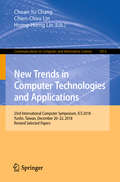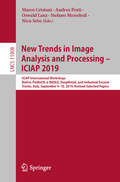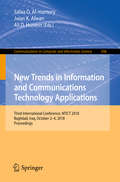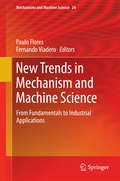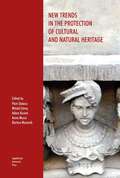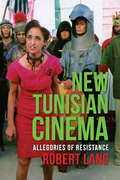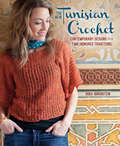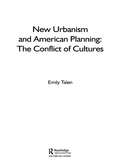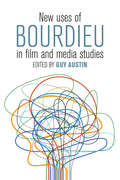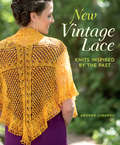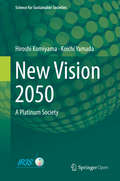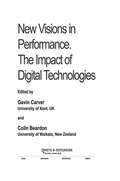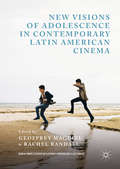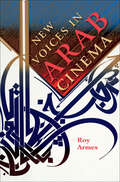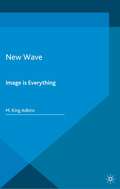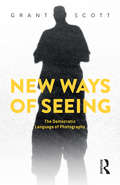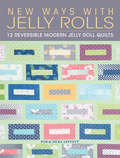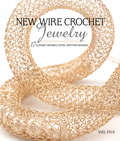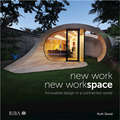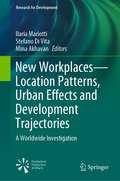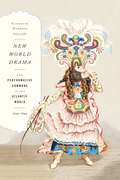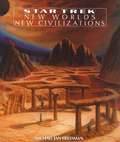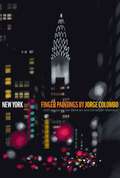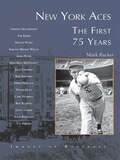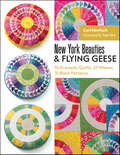- Table View
- List View
New Trends in Computer Technologies and Applications: 23rd International Computer Symposium, ICS 2018, Yunlin, Taiwan, December 20–22, 2018, Revised Selected Papers (Communications in Computer and Information Science #1013)
by Chuan-Yu Chang Chien-Chou Lin Horng-Horng LinThe present book includes extended and revised versions of papers presented during the 2018 International Computer Symposium (ICS 2018), held in Yunlin, Republic of China (Taiwan), on December 20-22, 2018.The 86 papers presented were carefully reviewed and selected from 263 submissions from 11 countries. The variety of the topics include machine learning, sensor devices and platforms, sensor networks, robotics, embedded systems, networks, operating systems, software system structures, database design and models, multimedia and multimodal retrieval, object detection, image processing, image compression, mobile and wireless security.
New Trends in Image Analysis and Processing – ICIAP 2019: ICIAP International Workshops, BioFor, PatReCH, e-BADLE, DeepRetail, and Industrial Session, Trento, Italy, September 9–10, 2019, Revised Selected Papers (Lecture Notes in Computer Science #11808)
by Nicu Sebe Marco Cristani Oswald Lanz Stefano Messelodi Andrea PratiThis book constitutes the refereed proceedings of five workshops and an industrial session held at the 20th International Conference on Image Analysis and Processing, ICIAP 2019, in Trento, Italy, in September 2019: Second International Workshop on Recent Advances in Digital Security: Biometrics and Forensics (BioFor 2019); First International Workshop on Pattern Recognition for Cultural Heritage (PatReCH 2019); First International Workshop eHealth in the Big Data and Deep Learning Era (e-BADLE 2019); International Workshop on Deep Understanding Shopper Behaviors and Interactions in Intelligent Retail Environments (DEEPRETAIL 2019); Industrial Session.
New Trends in Information and Communications Technology Applications: Third International Conference, NTICT 2018, Baghdad, Iraq, October 2–4, 2018, Proceedings (Communications in Computer and Information Science #938)
by Safaa O. Al-mamory Jwan K. Alwan Ali D. HusseinThis book constitutes the refereed proceedings of the Third International Conference on New Trends in Information and Communications Technology Applications, NTICT 2018, held in Baghdad, Iraq, in October 2018.The 18 papers presented were carefully reviewed and selected from 86 submissions. The papers are organized in topical sections, namely: Computer networks; system and network security; machine learning; intelligent control system; communication applications; computer vision; and e-learning.
New Trends in Mechanism and Machine Science
by Paulo Flores Fernando ViaderoThis work presents the most recent research in the mechanism and machine science field and its applications. The topics covered include: theoretical kinematics, computational kinematics, mechanism design, experimental mechanics, mechanics of robots, dynamics of machinery, dynamics of multi-body systems, control issues of mechanical systems, mechanisms for biomechanics, novel designs, mechanical transmissions, linkages and manipulators, micro-mechanisms, teaching methods, history of mechanism science and industrial and non-industrial applications. This volume consists of the Proceedings of the 5th European Conference on Mechanisms Science (EUCOMES) that was held in Guimarães, Portugal, from September 16 - 20, 2014. The EUCOMES is the main forum for the European community working in Mechanisms and Machine Science.
New Trends in the Protection of Cultural and Natural Heritage
by Piotr Dobosz, Witold Górny, Adam Kozień, Anna Mazur, Bartosz MazurekThe book entitled New Trends in the Protection of Cultural and Natural Heritage is a collection of twelve scientific articles (chapters) authored by Polish and foreign researchers in the field of cultural heritage protection. Specializing in various scientific disciplines (including legal, architectural, managerial, cultural studies considerations) and at different stages of scientific development, the authors of the individual texts from either a casuistic (case studies) or systemic (studies of normative solutions or development trends) perspective analyze new trends in the protection of cultural and natural heritage.
New Tunisian Cinema: Allegories of Resistance (Film and Culture Series)
by Robert LangTunisian cinema is often described as the most daring of all Arab cinemas. For many, Tunisia appeared to be a model of equipoise between "East" and "West," and yet, during Zine El Abidine Ben Ali's presidency, from 1987 to 2011, the country became the most repressive state in the Maghreb. Against considerable odds, a generation of filmmakers emerged in the mid-1980s to make films that are allegories of resistance to the increasingly illiberal trends that were marking their society.In New Tunisian Cinema, Robert Lang focuses on eight films by some of the nation's best-known directors, including Man of Ashes (1986), Bezness (1992) and Making Of (2006) by Nouri Bouzid, Halfaouine (1990) by Férid Boughedir, The Silences of the Palace (1994) by Moufida Tlatli, Essaïda (1997) by Mohamed Zran, Bedwin Hacker (2002) by Nadia El Fani, and The TV Is Coming (2006) by Moncef Dhouib. He explores the political economy and social, historical, and psychoanalytic dimensions of these works and the strategies filmmakers deployed to preserve cinema's ability to shape debates about national identity. These debates, Lang argues, not only helped initiate the 2011 uprising that ousted Ben Ali's regime but also did much to inform and articulate the aspirations of the Tunisian people in the new millennium.
New Tunisian Crochet: Contemporary Designs from Time-Honored Traditions
by Dora OhrensteinTunisian crochet is hot! Open the door and discover many designers and 30+ Tunisian stitch patterns.Tunisian crochet, a technique dating back to the nineteenth century, has recently been making its way back into the hands of crocheters. Here, author Dora Ohrenstein presents more than 30 Tunisian stitch patterns and 11 projects, updating historic concepts and introducing innovative techniques using contemporary styles and yarns. The door has officially been opened for those interested in rediscovering this treasured craft.In The New Tunisian Crochet, you'll begin with Tunisian stitch patterns to create a variety of beautiful fabrics you'll love. Next, follow the inspiration of some of crochet's masters with projects that showcase these stitches in a variety of garments, accessories, and home decor projects. Get ready to explore a craft that's received a fresh jolt of inspiration and insight in The New Tunisian Crochet.
New Urbanism and American Planning: The Conflict of Cultures (Planning, History and Environment Series)
by Emily TalenNew Urbanism and American Planning presents the history of American planners’ quest for good cities and shows how New Urbanism is a culmination of ideas that have been evolving since the nineteenth century. In her survey of the last hundred or so years of urbanist ideals, Emily Talen identifies four approaches to city-making, which she terms ‘cultures’: incrementalism, plan-making, planned communities, and regionalism. She shows how these cultures connect, overlap, and conflict and how most of the ideas about building better settlements are recurrent. In the first part of the book Talen sets her theoretical framework and in the second part provides detailed analysis of her four ‘cultures’.She concludes with an assessment of the successes and failures of the four cultures and the need to integrate these ideas as a means to promoting good urbanism in America.
New Uses of Bourdieu in Film and Media Studies
by Guy AustinThrough his influential work on cultural capital and social mobility, the French sociologist Pierre Bourdieu has provided critical insights into the complex interactions of power, class, and culture in the modern era. Ubiquitous though Bourdieu's theories are, however, they have only intermittently been used to study some of the most important forms of cultural production today: cinema and new media. With topics ranging from film festivals and photography to constantly evolving mobile technologies, this collection of essays demonstrates the enormous relevance that Bourdieu's key concepts hold for the field of media studies, deploying them as powerful tools of analysis and forging new avenues of inquiry in the process.
New Vintage Lace: Knits Inspired By the Past
by Andrea JurgrauEnjoy gorgeous projects that include hats, small and large shawls (circular, semi-circular, and triangular), scarves, and wraps - all inspired by traditional lace doily patterns. Lace-knitter Andrea Jurgrau shows how she creates her patterns, lifting or creating and adjusting individual motifs, then reworking and combining them into original, unique works of wearable art.Take knitted doilies to another level! Intricate, delicate, and from the past, Andrea readily acknowledges that you might not have a use for such items. In her book New Vintage Lace, you'll find a collection of 18 fully-charted projects that she has altered and adapted into fresh wearable accessories suited to more modern styles and tastes.Andrea shows you many particulars of lace knitting - explaining special stitches, how to read both charts and your own knitting, different ways of adding beads, and the importance of proper blocking. New Vintage Lace will take you beyond the current trends and leave you wanting more.
New Vision 2050: A Platinum Society (Science For Sustainable Societies Ser.)
by Hiroshi Komiyama Koichi YamadaThis book presents the "New Vision 2050," which adds the concept of the “platinum society” to the “Vision 2050”.The 20th century was a century in which energy led the development of material civilization, resulting in deletion of resources, global warming and climate change. What form should sustainable material and energy take to protect the Earth? The "Vision 2050" was established 20 years ago as a model that we should pursue for the next half century. Fortunately, the world is on course for the Vision 2050.The 21st century will be a century in which we seek qualitative richness, with the Vision 2050 as the material basis. That is, a “platinum society” that has resource self-sufficiency and resource symbiosis, and where people remain active throughout their lives and have a wide range of choices and opportunities for free participation. Since the author presented the concept of "Vision 2050" in 1999, the idea has been introduced in two books entitled Vision 2050: Roadmap for a Sustainable Earth (2008) and Beyond the Limits to Growth: New Ideas for Sustainability from Japan (2014). The latter includes a chapter that sheds light on the concept of a “platinum society”. In this publication, the author presents the "New Vision 2050" in more detail.
New Visions In Performance: The Impact Of Digital Technologies (Innovations in Art and Design)
by Gavin Carver Colin BeardonNew Visions in Performance features the work of twelve performers and academics who are concerned with the integration of digital technologies into theatrical performance.
New Visions of Adolescence in Contemporary Latin American Cinema (New Directions in Latino American Cultures)
by Rachel Randall Geoffrey MaguireThis volume explores the recent ‘adolescent turn’ in contemporary Latin American cinema, challenging many of the underlying assumptions about the nature of youth and distinguishing adolescence as a distinct and vital area of study. Its contributors examine the narrative and political potential of teenage protagonists in a range of recent films from the region, acknowledging the distinct emotional registers that are at play throughout adolescence and releasing teenage subjectivities from restrictive critical and theoretical emphases on theories of childhood. As the first academic study to examine the figure of the adolescent in contemporary Latin American film, New Visions of Adolescence in Contemporary Latin American Cinema thus presents a timely and innovative analysis of issues of sexuality and gender, political and domestic violence and social class, and will be of significant interest to students and researchers in Latin American Studies, Cultural Studies, World Cinema and Childhood Studies.
New Voices in Arab Cinema
by Roy ArmesNew Voices in Arab Cinema focuses on contemporary filmmaking since the 1980s, but also considers the longer history of Arab cinema. Taking into consideration film from the Middle East and North Africa and giving a special nod to films produced since the Arab Spring and the Syrian crisis, Roy Armes explores themes such as modes of production, national cinemas, the role of the state and private industry on film, international developments in film, key filmmakers, and the validity of current notions like globalization, migration and immigration, and exile. This landmark book offers both a coherent, historical overview and an in-depth critical analysis of Arab filmmaking.
New Wave: Image is Everything (Pop Music, Culture and Identity)
by K. AdkinsNew Wave: Image is Everything traces the evolution of the often neglected pop music genre, new wave. Using artists from Elvis Costello to Cyndi Lauper as illustrations, the book argues that new wave was among the first flowerings of postmodern theory in popular culture.
New Ways of Seeing: The Democratic Language of Photography (Criminal Practice Ser.)
by Grant ScottThose born since the digital revolution, seem to have the hardest time re-imagining the role of photography in the world today. Thinking of photography as a visual language is the approach this book adopts to addresses this challenge.Considering photography in this way develops the metaphor of 'learning a language' when attempting to explain what photography can be, and what it can give a student in transferable creative and life skills. This begins with challenging the pre-conception that successful photography is defined by the successful single image or 'the good photograph'.The book emphasises the central role of narrative and visual storytelling through a technique of 'photosketching' to develop the building blocks of visual creativity and ultimately to craft successful bodies of photographic work.New Ways of Seeing explains how to both learn and teach photography as a visual language, appropriate for both professionals and students working today.
New Ways with Jelly Rolls: 12 Reversible Modern Jelly Roll Quilts
by Nicky Lintott Pam LintottCreate stylish, modern jelly roll quilts with these twenty-four quick and easy designs compiled by the bestselling authors of Dessert Roll Quilts. Love quilting with jelly rolls? This new collection of quilts by bestselling authors Pam & Nicky Lintott combines the ease and speed of using jelly rolls with twelve stunning contemporary designs for modern quilts. Also features twelve original designs for the quilt backs using the leftover jelly roll scraps, making these quilts reversible and creating a collection of twenty-four quilt designs to try! · Includes step-by-step instructions for quick and easy piecing· Use up all those jelly roll leftovers with the quilt back designs· Features twenty-four modern quilt designs for contemporary quilters
New Wire Crochet Jewelry
by Yael FalkJewelry makers and wirework artists! We know how much you love exploring fresh and innovative techniques. Wire Crochet Jewelry is your new, must-have guide to creating smart, sophisticated jewelry designs with hook and wire. Beautiful crochet jewelry can be made of thread or yarn, of course, but you really expand your options when you learn to crochet with wire and beads. Popular designer Yael Falk's step-by-step tutorials make it easy to create a variety of projects. Open this book and discover: • Materials information on choosing the right wires, crochet hooks, jewelry tools, and beads. • Detailed how-to information on crocheting contemporary wire jewelry, stitch-by-stitch. • Plus 17 projects shown step-by-step that make wire crochet designs achievable for a variety of skill levels. Look at your wire in a whole new way when you learn to crochet jewelry. Wire Crochet Jewelry will show you how!
New Work, New Workspace: Innovative design in a connected world
by Ruth SlavidDoes it matter where and how we work any more? Increasingly, many of us can work anywhere, so what is the meaning of the dedicated workspace? With 30 detailed case studies of all kinds of workspaces – from traditional workspaces to writer’s sheds and studios – this book argues that a specific place to work is still needed but that the kind of space is changing fast. As social interaction is favoured over places to toil, and as millennials and Generation X take a very different attitude to work than their predecessors, being more concerned with completing tasks than presenteeism, so the needs of design change. There are increasing metrics for measuring the effectiveness of workspace, and they show that good design – design that is focused on the environment and wellbeing that the workforce needs – is valued. At the same time, there are more generic spaces, such as co-working spaces, that have to fit all – or at least all of the target community. Case studies include: 80 Atlantic Avenue, Toronto Nick Veasey studio and gallery, Kent Kostner House, Italy GS1, Lisbon.
New Workplaces—Location Patterns, Urban Effects and Development Trajectories: A Worldwide Investigation (Research for Development)
by Ilaria Mariotti Stefano Di Vita Mina AkhavanThis book explores the innovative workplaces, namely coworking spaces and makerspaces, that are emerging as a consequence of digital innovations and the related development of the knowledge economy and society in the wake of deindustrialization. Drawing on international and multidisciplinary research projects, fresh insights are provided into current trends, research methodologies, actors, location patterns and effects, and urban and regional policies and planning. The aim is to cast light on all aspects of these new working and making spaces, highlighting their innovative geographies and the complexities of their nexus with urban and regional change processes from both the theoretical and the empirical point of view. The book includes multiple illuminating case studies from the advanced economies of North America and Europe, carefully selected for their relevance to the topic under analysis. This book is designed for an international audience comprising not only academicians but also policymakers, representatives of civil and entrepreneurial associations, and business operators.
New World Drama: The Performative Commons in the Atlantic World, 1649–1849
by Elizabeth Maddock DillonIn New World Drama, Elizabeth Maddock Dillon turns to the riotous scene of theatre in the eighteenth-century Atlantic world to explore the creation of new publics. Moving from England to the Caribbean to the early United States, she traces the theatrical emergence of a collective body in the colonized New World--one that included indigenous peoples, diasporic Africans, and diasporic Europeans. In the raucous space of the theatre, the contradictions of colonialism loomed large. Foremost among these was the central paradox of modernity: the coexistence of a massive slave economy and a nascent politics of freedom. Audiences in London eagerly watched the royal slave, Oroonoko, tortured on stage, while audiences in Charleston and Kingston were forbidden from watching the same scene. Audiences in Kingston and New York City exuberantly participated in the slaying of Richard III on stage, enacting the rise of the "people," and Native American leaders were enjoined to watch actors in blackface "jump Jim Crow." Dillon argues that the theater served as a "performative commons," staging debates over representation in a political world based on popular sovereignty. Her book is a capacious account of performance, aesthetics, and modernity in the eighteenth-century Atlantic world.
New Worlds, New Civilizations: Star Trek All Series (Star Trek)
by Michael Jan FriedmanThey said it couldn't be done ... all the myriad worlds which have been sought out and explored through more than 500 television episodes and nine Star Trek movies, mapped, illustrated and brought to life in the pages of a comprehensive Star Trek atlas. From the comparatively crowded space of the Alpha and Beta Quadrants, home to Earth and Vulcan, Bajor and Betazed, the Cardassian Union and the Romulan and Klingon Empires; to the distant Gamma Quadrant controlled by the Dominion; to the far reaches of the Delta Quadrant, home space of the Borg, where of Federation explorers only the crew of the USS Voyager has ever been; NEW WORLDS, NEW CIVILIZATIONS catalogues peoples and planets from all four corners of the galaxy. Ever wondered where the blue-skinned Bolians originated from? Or what it is like on the permanently frozen homeworld of the bloodless Breen? From the first world that the first away team landed on under the command of Christopher Pike in the original pilot episode 'The Cage' (a world that has been off-limits to the Federation ever since), to the world of the Ba'ku as seen in 'Star Trek: Insurrection', all these and many more are described and depicted in all their fascinating detail by a team of star-studded contributors. Produced in the finest tradition of bestselling Star Trek illustrated reference from Pocket Books such as The Art of Star Trek and Where No Man Has Gone Before, NEW WORLDS, NEW CIVILIZATIONS will be an essential addition to every Trekker's shelves.
New York
by Jen Bekman Christoph Neimann Jorge ColomboIf New York City is a state of mind, then Jorge Colombo captures the metropolis' thoughts like no other. Colombo's beautiful illustrations of New York City have graced the cover of The New Yorker several times, brilliantly depicting icons such as silhouetted rooftop water towers, the illuminated Chrysler Building at night, Fifth Avenue in the snow, or the ubiquitous hot dog stand. All of the images were finger painted on location on an iPhone; to passerby walking by the artist, he simply appeared to be sending text messages or reading a very long email. This sophisticated volume presents one hundred of his best pieces in full colour, accompanied by his recollections and comentaries about each location. Every scene is unmistakably New York: familiar, grand, timeless, yet filtered by modern, cutting-edge technology. Immediately recognizable to native New Yorkers, but also perfect for anyone who admires the Big Apple, this is a monograph of an artist and of a city.
New York Aces: The First 75 Years (Images of Baseball)
by Mark RuckerIt was in the New York City area in the mid-nineteenth century that various pitching styles were invented, developments that changed baseball history. In 1883, the Giants became a powerhouse, hiring the finest pitchers in the country. In the twentieth century, the talent pool kept changing, but the quality did not. Christy Mathewson, "Iron Man" McGinnity, and Rube Marquard all won more than two hundred games in the majors, and each played a part in many pennant victories for John McGraw's Giants. In 1921, the Yankees won their first championship, and their domination of the American League that followed was unprecedented. Pitching was both effective and exciting for New York fans, whether in Yankee Stadium or the Polo Grounds. New York Aces: The First 75 Years covers the history of pitching in the Big Apple, with equal attention to the American League and National League franchises.
New York Beauties & Flying Geese: 10 Dramatic Quilts, 27 Pillows, 31 Block Patterns
by Carl HentschDramatic curves and angles for today's adventurous quilter Become a skilled foundation piecer with New York Beauty blocks and arcs of Flying Geese that amaze! Carl Hentsch simplifies a technique loved by many with his straightforward approach to curved piecing, foundation piecing, and simple machine appliqué. Stitch your way through 31 architectural block patterns, ideal for advanced beginners and intermediate quilters. Then it's time to practice on 10 full-size quilts and 27 bonus pillow projects with lively color combinations to provide movement and drama. In a personal foreword, fabric designer Tula Pink discusses how she met Carl and came to collaborate with him on the color choices for his quilts. • Complex piecing made simple! Expand your skill set and learn new tips and techniques for curved and foundation piecing • Traditional blocks shine with the use of modern fabrics in rich color stories, with fabric selections by Tula Pink • Practice your newfound skills on a small project with stunning round pillows designed to accompany each quilt
